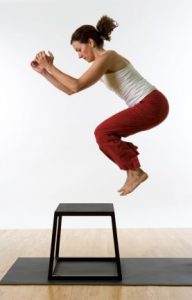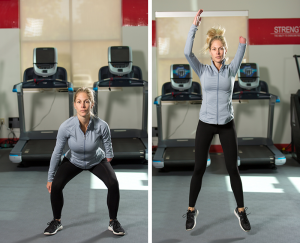Plyometrics is a combination of high-intensity exercises that are aimed at developing your muscle strength and your body’s endurance. Plyometric exercises are the mainstay of training that is used by both professional athletes and beginners.

Plyometrics became popular in the United States back in the 1980s. Professional athletes have used these exercises to prepare for various competitions. Gradually, this method became popular among trainers who helped their clients lose weight and improve their body quality.
Athletes who prefer HIIT or CrossFit use this method to increase the effectiveness of their training.
The majority of plyometric exercises are jumping, although plyometrics also use strength exercises that are performed in dynamics.
Plyometric exercises vary in difficulty, so you can choose exercises based on your physical capabilities and health.
Low intensity is suitable for beginner athletes. These include:
- Jumping jack
- Plank jack
- High Knees
- Skater
- Ski jump
- Mountain climbers
Middle difficulty level:
- Lunge jump
- Plank tuck in out
- 180 ° Jump
- Front Kick
- Crab Kicks
- Squat Jump
The high level of difficulty is suitable for advanced athletes but has a high level of injury:
- Tuck jump
- Push-up with Clap
- Burpee
- X-jump
- Donkey Kicks
The effect of plyometric exercises on your body.
- Burn excess fat. You burn more calories and start metabolic processes with high-intensity exercise.
- Develop endurance. This type of exercise has a cardio effect, so it will train your heart and increase your endurance.
- Increases muscle strength and power.
The uniqueness of plyometric exercises lies in the shortening of the time between stretching and contracting. This effect on the muscles makes them respond instantly to the load. Thanks to this effect, plyometrics is an effective way to lose weight, increase muscle mass, tonic the body, and increase metabolism.
Because jumps have a high level of injury, you should use them with caution. Before you decide to include them in your main training course, consult your doctor. Also, you should not neglect the rules of these exercises, it will reduce the risk of injury.
If you decide to use this type of exercise, then you must understand that not only your body will be changed, but also your quality of life.

Benefits of plyometric exercises.
Help you lose weight.
Due to the high intensity, plyometric exercises consume a lot of energy. Your body takes this energy from your fat reserve, and it starts to decrease.
Improves muscle mass.
Plyo workout is a combination of cardio and strength training. Therefore, your muscles receive an extra load that increases their growth. And you probably know that the more muscles on your body, the less fat. This allows your muscles to naturally reshape and make your body lean. These exercises don’t destroy muscle tissue, unlike classic cardio workouts. After regular workouts, you get a lean and toned body.
Improves the work of the cardiovascular system.
Cardio exercises train your heart and improve blood circulation. Therefore, using plyometrics, you improve the endurance of the heart and prevent the development of cardiovascular diseases.
Helps reduce thighs.
Even though local weight loss is a myth that has long been debunked, plyometric exercises have a high local impact on the glutes, hips, and legs. These parts of the body are most involved during the jump, so they are the first to react to the load.
Lack of auxiliary equipment.
Plyometric exercises do not require any additional sports equipment. You train only with your body weight. Therefore, you can use this technique at home, outdoors, and in the gym. You can only use leg weights to increase the level of stress. But this is not a prerequisite for achieving high results.
Increases metabolism.
Because more and more people around the world have a sedentary lifestyle, they have a low metabolic rate, which leads to health problems and obesity. Thus, plyometric exercise is a way to improve blood circulation in the body and get the necessary physical activity that will enhance the exchange of societies and improve your condition.
Cons of plyometric workouts
As with any intense exercise, plyometrics has many disadvantages that can worsen your health if you have any medical conditions.
Cons of plyometrics:
- high load on joints, knees;
- high risk of injury,
- increases heart rate,
- great stress on the spine.
Therefore, if you have problems with the health of the cardiovascular, musculoskeletal systems, arthritis, rheumatism, large excess weight, fragile bones, then you should not use plyometric exercises until you improve your health and get rid of health problems.
This type of training is more suitable for healthy people who have a variety of training experiences.
Comments are closed, but trackbacks and pingbacks are open.